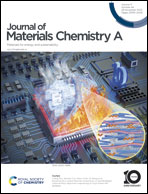Impact of side-chain deuteration on the molecular stacking and photovoltaic performance of non-fullerene acceptors†
Abstract
The deuterium isotope effect plays a profound role in revealing the kinetics and mechanisms of organic reactions, as well as the hole/electron transport behaviors of semiconductors, yet the application of the deuterium isotope effect in organic solar cells has not been fully explored due to the challenging nature of synthesis. Here, we aim at addressing this conundrum by designing and synthesizing two asymmetric non-fullerene acceptors, BTP-POE-H and BTP-POE-D. Particularly, the effect of deuterium isotope effects on their optoelectronic properties and photovoltaic properties was investigated. Attractively, a higher power conversion efficiency (PCE) of 16.5% and an impressive fill factor of 78% were achieved for the deuterated acceptor BTP-POE-D compared to the control BTP-POE-H under the same conditions. The high fill factor of BTP-POE-D based devices can be attributed to their higher and more balanced charge transport, weaker bimolecular recombination, more ordered molecular stacking and suitable length scale of phase separation, as revealed by grazing incidence X-ray diffraction and transmission electron microscopy measurements. These results not only advance our understanding of the structure–performance relationships of deuterium-substituted acceptors, but also provide a new avenue to design high-performance nonfullerene acceptors.



 Please wait while we load your content...
Please wait while we load your content...